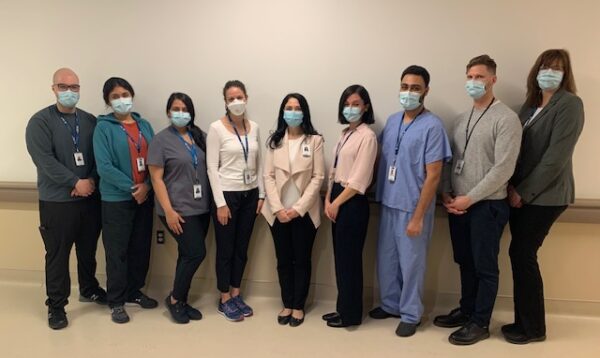HEART Program Wins 3M Health Care Quality Team Award
01
Jun
2022
The Canadian College of Health Leaders (CCHL) and 3M Canada Company have announced that Humber River Health’s Elderly Assess and Restore Team (HEART) is the recipient of the 3M Health Care Quality Team Award- Quality improvement initiative(s) within an organization. This award recognizes teams for exceptional innovation, quality, patient and family engagement, and teamwork. This article gives a detailed overview of how the HEART program incorporates these elements to advance quality improvement on a single aspect of care within the organization.
Background
Humber River Health serves the North West Toronto community, which has the highest number of seniors in Ontario, with this number expected to double by 2036. Patients aged 65 and above account for 38 per cent of hospital admissions and 65 per cent of inpatient census at Humber River Health. Older adults who are admitted to the hospital are often bedridden and are at risk of functional decline that could become permanent. This accelerated functional loss can lead to subsequent readmissions to the hospital. Humber River Health has recognized the need for a dedicated senior friendly strategy to better respond to the healthcare needs of our patient population. The Seniors Care Strategy was established in 2018 and included the implementation of an innovative Assess and Restore (A&R) model of care- HEART. A&R models in Ontario include short-term rehabilitative and restorative care treatments intended to increase the strength, mobility and functional ability for frail seniors. HEART offers a blueprint for scale and spread for hospitals looking to implement similar models.

HEART is comprised of occupational therapists, physiotherapists, rehabilitation assistants, and registered practical nurses and serves a subset of “high-risk” frail seniors that have restorative potential and can benefit from assess and restore interventions. HEART is an innovative mobile service that operates 7 days a week with both inpatient and outpatient components, and was implemented to optimize patient function, reduce length of stay (LOS), facilitate home discharge, and promote healthy aging in the community.
From September 2018 to September 2021, HEART served 1109 patients. Of these, 98.3 per cent maintained or improved their functional capacity, with an average 36.7 per cent improvement in function, and 87.7 per cent were discharged home to their baseline. Furthermore, HEART participants had a lower average LOS when compared to similar non-participants (7.5 vs. 12 days), resulting in savings of 4990 bed days and approximately $4.6 million in cost savings.
Innovation
One of the many tiles utilized within Humber River Health’s Command Centre is the Seniors Care Tile, which was created to further the implementation of the HEART program. The Seniors Care Tile monitors seniors that are eligible for HEART, promotes the resolution of delays in assessments and interventions, and allows for the rapid response to declining patient condition or function. This tile captures the number of senior patients screened and enrolled, and is monitored 24/7 by inpatient unit leads and the Command Centre staff.
If a geriatric patient is falling off their specialized plan, the staff at the Command Centre are alerted of this through the tile by the system’s artificial intelligence (AI). The system’s AI works with technologies on the floor with healthcare providers, such as patient monitors, to detect anything that could be a risk. HEART has been integrated with existing clinical processes including the Discharge Planning Pathway and SMART Discharge Protocol.
Externally, the program demonstrates evidence-based innovations by highlighting the importance of A&R programs. Research results were published in Archives of Gerontology and Geriatrics that showed that the HEART program reduces the likelihood of institutionalization, decreases LOS, and decreases the likelihood of requiring an alternate level of care (ALC). An additional research paper on HEART published in Geriatrics explored predictive characteristics that should be considered when enrolling patients in A&R programs for optimal clinical outcomes and has been translated into practice.

Quality
Prior to the implementation of HEART, initiation of occupational therapy and physiotherapy services for frail high-risk older adults with restorative potential was dependent on a physician referral, which meant that patients could be waiting 48 hours or longer before receiving therapy. Patients, regardless of frailty or restorative potential received therapy approximately 2-3 times per week, with no therapy delivered on the weekends. Previously, patients regardless of frailty or restorative potential did not received follow-up support upon discharge.
This led to the need for early A&R interventions targeted at frail older adults with restorative potential and at risk for functional decline and discharge complexity. In order to monitor the quality improvements, health records data is utilized to capture LOS, readmissions, discharge destinations and visits to the ED following discharges. To monitor progress, monthly metrics are compiled for both inpatients and outpatients.
A focus group with HEART staff was conducted to determine the sustainability of the program and identify needed changes. A culture of continuous quality improvement was created by engaging all team members in formal reports and follow-up, building staff capacity. Leadership continuously reviewed data and communicated progress to team members, celebrating successes.
Patient and Family Engagement
The HEART team creates a specific discharge plan to ensure proper supports at home to bolster independent living and reduce caregiver burden. Following enrollment, patients and their families are engaged in assessment and goals setting as well as discharge planning. Prior to discharge, HEART staff review discharge plans and services with the patient and family, advocate for further needs, and seek patient consent to continue the outpatient stream of the program and initiates referrals to services as required. If a patient consents to outpatient follow-up, the HEART registered practical nurse (RPN) conducts a virtual visit through telephone with the patient upon discharge from the hospital. This visit offers education on the patient’s condition, review compliance with their home program, and continues to coordinate services the patient may need such as scheduling follow-up appointments with a specialist, referral to Home and Community Care Support Services (HCCSS) for services, referral to the Geriatric Outreach Team and/or outpatient clinics and services, etc.
The Patient Discharge Call Centre conducted surveys with discharged patients to gather their experiences. Ninety per cent of HEART participants reported that they would recommend this program to others, and approximately 87 per cent reported an overall positive experience with the program.
Teamwork
The HEART program works in collaboration with clinical teams across the hospital to deliver care, and with the HCCSS to support transitions to community. Allied health staff, nursing, physicians, information services (IS), decision support services (DSS), and other teams were engaged in this organization-wide strategy to provide optimal care. The Seniors Care Program director, Beatrise Edelstein, promoted HEART with senior leadership, frontline leaders and staff and physicians, as well as community partners.
Required changes were identified and implemented as a result of staff feedback during focus groups as part of the quality improvement initiative.
Conclusion
The HEART program provides direct impact to patients with improved functional ability, increased discharge home and positive patient experience. Upon discharge from the hospital, a majority of patients return home to the community, with few patients requiring inpatient rehabilitation prior to returning home. The HEART program achieves excellent patient outcomes and experience, is supported by staff, and optimizes hospital resource utilization, achieving quadruple aim. With an increasing senior population, it is important to consider care that is tailored to their unique needs. This is a valuable initiative to be considered for implementation by other acute care hospitals for greater impact.
